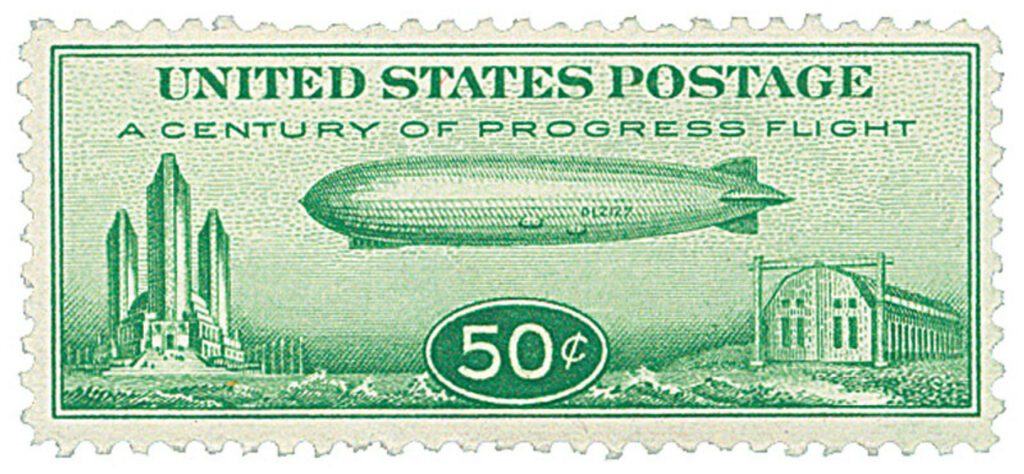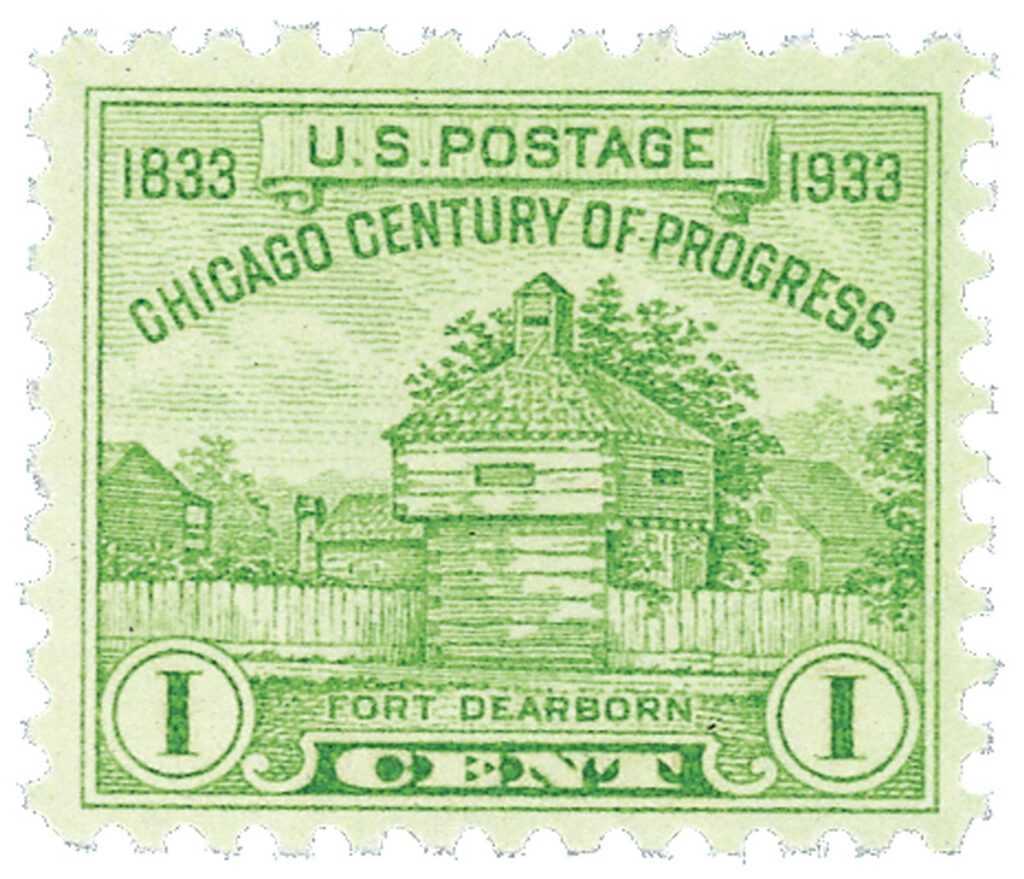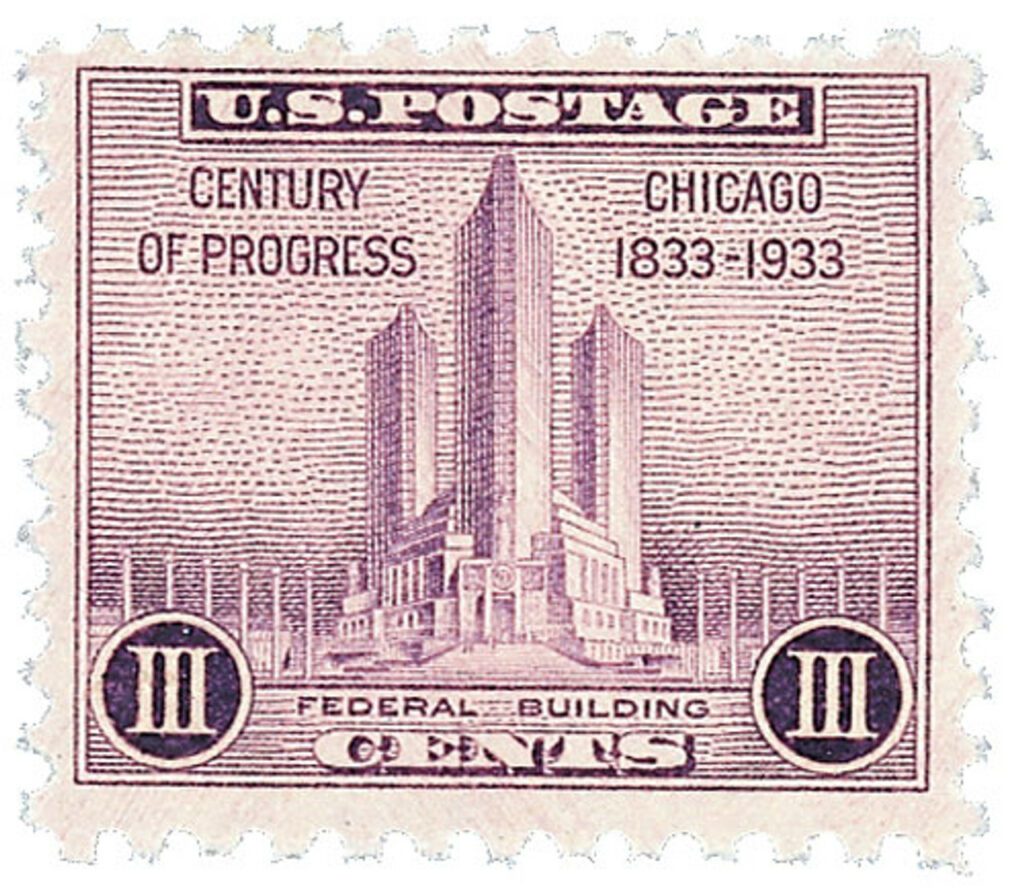On October 2, 1933, the Century of Progress airmail stamp, affectionately known as “Baby Zepp” was issued. It sold poorly at the time and 90% of the stamps were destroyed, leaving a relatively small number available today.
In the 1920s, Germany’s Luftschiffbau Zeppelin company offered to build the US a dirigible as payment for debt from World War I. America agreed, with the stipulation that the airship had to prove itself in a transatlantic journey. On October 16, 1924, the LZ 126 arrived in New Jersey. This was the start of Graf Zeppelin flights between the US, South America, and Europe, with mail carried to all stops along the way.
The US postmaster general decided to issue a new set of stamps specifically for mail carried on these flights. The new stamps would subsidize the flights. Three zeppelin stamps were issued in 1930. The fourth was issued in 1933 to help pay for the Graf Zeppelin flight to Chicago. At the time, the city was holding the Chicago World’s Fair, titled “A Century of Progress.”
Held on the shore of Lake Michigan, this gigantic fair celebrated the 100th anniversary of Chicago’s incorporation as a village. It featured outstanding science and industry exhibits and was a great economic aid to Chicago during the Great Depression.
On August 18, post office officials agreed to issue the 50¢ stamp, with 42½¢ from each stamp to go to the Zeppelin Company. Because its face value was much lower than that of the previous Zeppelin stamps, #C18 became known as “Baby Zepp.”
Victor McCloskey Jr., a Bureau of Engraving and Printing (BEP) employee, designed the new stamp. It pictures the Graf Zeppelin flying over the Atlantic Ocean. On the left is the federal building, representing the World’s Fair. The image on the right shows a zeppelin hangar in Friedrichshafen, Germany, where the flight started.
The BEP had just six weeks to produce and distribute the stamp so mail could travel by steamer to Germany and then return back to the US on a special flight. It was issued in five US cities on different days. The first city was New York, on October 2, and the last city was Chicago, on October 7.
On the Century of Progress flight, for which the #C18 stamp was issued, the Graf Zeppelin traveled from its home base at Friedrichshafen, Germany, to Brazil. The great airship then traveled to Miami, Florida, where it was supplied with more hydrogen. Another refueling stop was made at Akron, Ohio before the Graf Zeppelin reached Chicago. At each destination, huge crowds greeted the dirigible. The Graf Zeppelin arrived at the fairgrounds on October 26. After circling the air over the expo for two hours, it made a brief 25-minute landing and then took off for Akron, Ohio.
In spite of its attractive design and historic significance, #C18 sold poorly in 1933. Eventually, 90% of the stamps were destroyed – leaving a mere 324,000 for modern collectors.
The Graf Zeppelin aircraft was later grounded when the Hindenburg exploded on May 6, 1937. However, during its service, the Graf Zeppelin established an incredible performance record. It made 590 flights, including 144 ocean crossings, and covered more than one million miles. It carried over 13,000 passengers and 235,300 pounds of mail and freight.
| FREE printable This Day in History album pages Download a PDF of today’s article. Get a binder or other supplies to create your This Day in History album. |
Discover what else happened on This Day in History.





I would love to know how many of these stamps were produced and how many were sold before 90% we’re destroyed. I suppose the Zeppelin Company was only paying back the debt from the war with their labor to build this airship. Why did they receive 42.5¢ for each stamp sold?
10% = 324,000 sold
90% = 2,916,000 destroyed
Therefor the total issue was @3,240,000.
$0.425 of purchase price went to subsidize the flight–voluntary, not government (taxpayer) funded. Similar to semi-postal stamps.
Again, thanks to Mystic for the rich philatelic history!
Thank you to J.L.LaBrack for his reply and additional information which I found helpful and interesting.
Zeppelinpost-Belege sind bestimmt einer der interessantesten aller Flugpost-Philatelie-Enthuasten.
Es gibt Belege, die fast 100 Jahre später weder in den Katalogen von Michel, Sieger, Scott oder Longhi gelistet sind.
Jonas m Lanter, Zeppelinpost – Experte Switzerland
————
Zeppelin mail covers are certainly among the most interesting for all airmail philately enthusiasts.
There are covers that, almost 100 years later, are not listed in the Michel, Sieger, Scott, or Longhi catalogs.
Jonas m Lanter, Zeppelin Mail Expert Switzerland